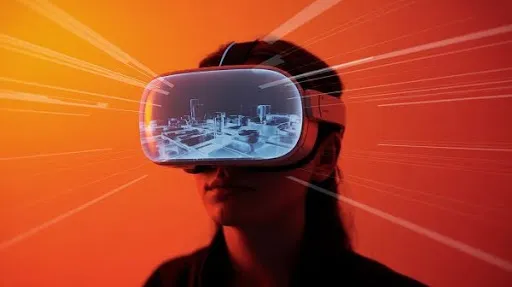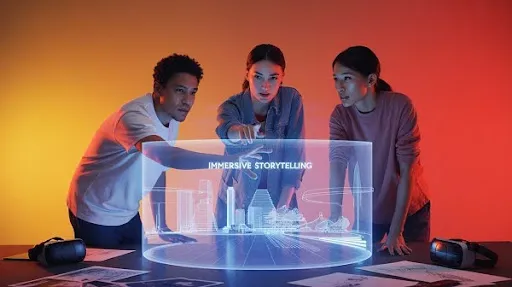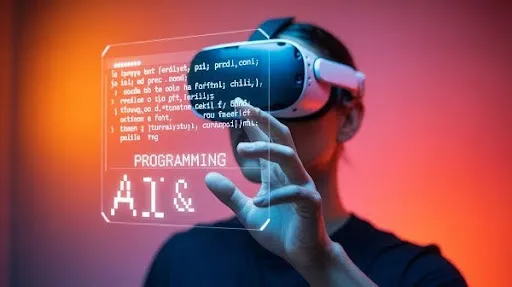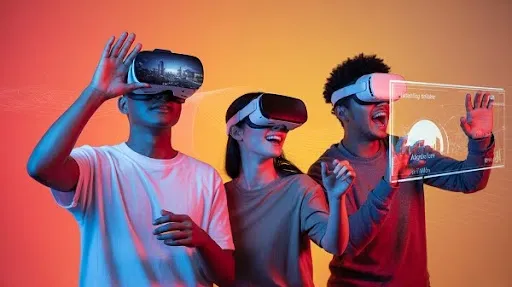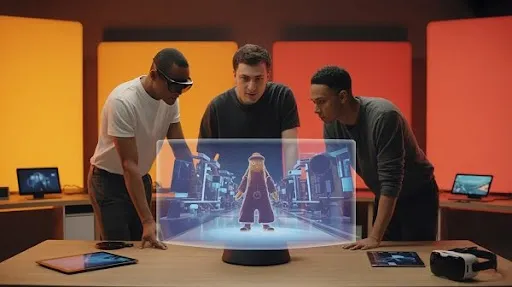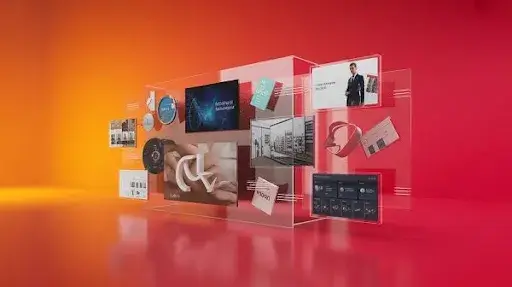Step inside a training room, and you’ll see a surgeon practicing without a patient. Go to a furniture store app, and you’ll watch a sofa drop into your living room without being delivered. That’s not magic—it’s 3D animation in VR and AR doing the heavy lifting.
These aren’t just visual effects. They’re experiences are built to feel real, react instantly, and hold your attention. And the demand is exploding. Over 10.8 million VR devices were sold in 2022. That number is expected to double by 2025.
Still think this is only for gamers? Think again.
3D animation in VR and AR is changing how we learn, shop, train, and even tell stories. The animation is no longer flat. It lives, breathes, and moves when you do.
Let’s break down how it works, where it’s going, and why smart businesses are investing in it—fast.
Why 3D Animation Is the Engine Behind VR and AR
You can build the tech. Sell the headset. Create the app. But if the animation doesn’t sell the experience, none of it matters.
What makes VR and AR convincing is the motion. The feeling that you’re part of something alive. That’s 3D animation in VR and AR at its core. It’s the layer that turns static models into reactive environments.
In virtual reality, animation creates entire interactive spaces. In augmented reality, it makes digital objects appear grounded in your real surroundings.
This is the difference between seeing a 3D chair and actually walking around it, flipping it, or watching it respond to your touch.
Industries Using 3D Animation in VR and AR
Gaming
Gaming leads the charge, naturally. In a VR game, you’re not just pressing buttons—you’re moving. Beat Saber is a great example. The blocks come at you, and your arms slice through them like you’re actually holding swords. The experience works because the animations are fast, responsive, and synced with the rhythm.
Marketing and Advertising
Brands use 3D animation in AR to make products feel personal. See how IKEA Place lets you drop a couch into your space? It’s more than a gimmick—it helps customers trust their purchase. That means fewer returns and higher confidence.
Education and Training
From medical students to machine operators, interactive training with virtual animations is safer, faster, and way more engaging. Platforms like Osso VR are letting doctors practice surgeries with animated patients before ever entering a real OR.
Planning the Animation Experience Right from the Start
Everything starts with pre-production. Without a concept and a clear storyboard, even the most advanced 3D animation will feel aimless.
Ask the basics:
- What’s the goal of the experience?
- What actions will the user take?
- Where does the user start, and how do they move?
These questions decide everything—the user flow, the camera angle, the interaction points.
For example, a training simulation for soldiers won’t use the same layout or animation logic as a shopping app. One needs realistic physical reactions. The other needs spatial product placement that adjusts in real-time.
A strong storyboard outlines all of this visually. It helps your team build animations that feel intentional, not stitched together.
Choosing the Right Animation and Modeling Tools
Blender
Open-source, free, and flexible. Blender is great for smaller or experimental projects in virtual reality animation. But it comes with a learning curve and lacks real-time performance for large-scale work.
Autodesk Maya
The go-to for high-end production. Known for realistic rigs and smooth character movements. Used often in VR training and cinematic experiences. It’s powerful but not cheap or beginner-friendly.
Unity and Unreal Engine
These aren’t just game engines—they’re engines for interaction. You’ll use them to program how objects respond, how physics work, and how animations behave in real-time.
Want to throw a virtual ball and have it bounce realistically? Unity or Unreal is where that happens.
Adobe Aero & Spark AR
Lightweight and built for quick augmented reality effects. Perfect for mobile campaigns or branded filters on Instagram or Snapchat.
Making 3D Animation Feel Real in AR and VR
Users notice flaws instantly. A glitch here, a lag there—it breaks immersion. That’s why performance isn’t a side task. It’s core to everything.
Keep your assets optimized:
- Use low-poly models to reduce load.
- Compress textures without losing visual quality.
- Stick to efficient lighting setups. Avoid heavy shadows and unnecessary reflections.
It’s a trade-off. But the right balance keeps the animation smooth across devices.
Adding Interactivity Through Programming and AI
This is where the magic meets the math. Game engines like Unity and Unreal let developers tie interactions to animations. That could mean grabbing objects, opening doors, or triggering actions based on user behavior.
Hand Tracking and Gesture Control
No controllers? No problem. With gesture tracking, users can manipulate objects just by moving their hands. This makes experiences feel more natural, especially in medical or industrial simulations.
Voice Commands
Telling a virtual assistant to open a menu or trigger a function saves clicks and makes the interaction smoother.
Eye Tracking
Some experiences react when you simply look at an object. No hands needed. This can add an extra layer of realism in creative VR environments or storytelling applications.
AI-Powered Behaviors
Want NPCs that react in real time? AI helps characters walk, talk, and respond without manually animating every move. With procedural animation, even unexpected events feel planned.
Testing and Getting Ready to Launch
3D animation in VR and AR must be tested across platforms—headsets, smartphones, AR glasses, and standalone systems.
Key areas to test:
- Performance – Does it lag? Any stuttering?
- Latency – Is there a delay when users interact?
- Comfort – Does it cause nausea? (A big deal in VR.)
You’ll also want to test AR applications under different lighting. If your sofa floats in the air because it can’t detect the floor correctly, users will lose trust in your product.
Interactivity and Spatial Awareness
Great augmented reality video and VR experiences are designed with spatial awareness. That means digital objects respect the rules of the physical world.
Depth Perception
Objects closer to the user should move differently from those farther away. Using parallax and focus shift tricks the brain into accepting the illusion.
Accurate Object Placement
Your 3D model shouldn’t float mid-air unless it’s meant to. It needs to lock into the environment and react if a user walks around it.
Bringing Interactivity to Life with 3D Animation in VR and AR
Static visuals don’t cut it anymore. In VR and AR, users don’t just watch — they act. Every scene, every object, every animation needs to react in real time. This is where 3D animation services shift VR and AR from mere aesthetics to being powerful.
Let Users Take Control
Once assets are modeled and optimized, the next step is making them interactive. In immersive environments, passivity kills engagement. Users expect control. That means tapping into scripting and behavior logic that brings the 3D world to life around them.
Scripting Makes It All Happen
Interactivity comes from code — plain and simple. Developers use Unity (C#) or Unreal Engine (Blueprints/C++) to program how 3D content reacts to users.
Tap a product in an AR retail app, and it spins open, revealing its parts. In VR medical training, look at a brain, and it highlights neural regions. These aren’t tricks — they’re carefully coded behaviors tied to inputs like:
- Touch or tap (common in AR on mobile)
- Eye tracking (used in VR headsets)
- Gesture recognition (through hand-tracking)
- Voice commands (for hands-free control)
Some projects just need light interactions — think of a simple museum app that highlights a sculpture on gaze. Others, like full-blown VR escape rooms, demand dozens of user-driven events, decision trees, and animation responses.
Real-Time Animation
Pre-rendered videos don’t work here. VR and AR need real-time rendering — animations that play, adjust, or change based on what users do in the moment.
That means using:
- State machines to handle behaviors like idle, walk, run, and react.
- Inverse Kinematics (IK) so limbs adjust when users move or touch objects.
- Physics-based animation to simulate gravity, impact, or realistic object motion.
If you throw a ball in VR, it should arc, bounce, maybe even knock something over. That’s real-time logic and animation working together — and it keeps things believable.
Feedback: Users Need to Know It’s Working
Animation without feedback is like a game without sound. Users need cues that their actions matter.
Good VR/AR apps build in feedback using:
- Visual signals (highlighting objects, glowing outlines, animation triggers)
- Sound effects (whooshes, taps, ambient noise)
- Haptics (vibration through VR controllers)
That little vibration when you open a virtual door or the whoosh when an object animates into place? That’s feedback. And it matters more than people realize. It reinforces immersion.
Don’t Let Interactivity Break Performance
Here’s the catch: all this interactivity and animation has a cost. It puts pressure on performance — and when that drops, so does the user experience.
To avoid that:
- Use low-poly models smartly — don’t overload scenes with details users won’t notice.
- Apply Level of Detail (LOD) systems so objects simplify as they get farther away.
- Compress textures and reuse assets with texture atlases.
- Bake animations when possible to reduce real-time processing load.
- Use culling techniques to skip rendering off-screen objects.
In VR, where motion sickness can hit fast, you need to maintain 72–90 FPS. Every frame counts. Poor optimization isn’t just bad — it’s physically uncomfortable for users.
Test, Then Test Again
You can’t build for just one device. Some users will have high-end headsets. Others will use AR on entry-level phones. And each device handles performance, tracking, and inputs differently.
That’s why cross-device testing is a must. Simulators can help in the early stages, but nothing beats running your app on real hardware. Test how animations behave on:
- Low-end AR phones with weaker sensors
- Mid-tier VR headsets with basic controllers
- High-end rigs like Meta Quest or HTC Vive
This isn’t optional. It’s how you ensure your animation logic and interactivity hold up everywhere.
The Challenges Behind Interactive Animation in VR and AR
The tools are out there. But building for immersive platforms comes with its own set of real-world problems. And you’ll run into them faster than you think.
Motion Sickness Is Real
Laggy animations. Jerky movement. Off-camera rotations. These are all culprits. If the visuals don’t line up with what users feel or expect, nausea kicks in fast.
Fixes include:
- Locking in steady frame rates
- Avoiding rapid camera shifts
- Using teleportation instead of free movement for navigation
This isn’t just a comfort issue — it directly affects how long people stay in your experience.
Making Interactions Feel Real
Users don’t just want things to react. They want those reactions to feel right. That’s hard to fake.
To pull this off:
- Use realistic physics so objects respond like they would in the real world.
- Blend animations smoothly between actions.
- Track user behavior in real-time and update animations on the fly.
When a virtual character turns to look at you, it should feel intentional — not robotic.
Graphics vs. Performance — Striking the Balance
Want stunning visuals? Great. But be ready to sacrifice speed — unless you plan smart.
Ultra-detailed animations may look good in a demo, but tank performance in real-time use. Find the balance. Use stylized design when you can, simplify effects, and aim for consistency over flash.
What Studios Get Right
Top-tier studios don’t just throw fancy visuals at a project. They stick to tried and tested practices that make VR and AR feel smooth, natural, and intuitive.
Start With Immersion in Mind
Everything — from interface to animation — should feel part of the 3D space. Avoid floating 2D animated menus unless you absolutely need them. Instead, use:
- Floating elements users can grab or swipe
- Environmental triggers that reveal options
- Spatial audio for audio cues and feedback
Use Motion Capture for Realism
For human movement, nothing beats MoCap. Capturing real actor movements and blending them with animation logic gives you a natural, responsive feel that’s tough to replicate by hand.
It’s especially useful in training simulations, VR storytelling, or character-driven scenes.
Optimize Early, Not Later
Don’t wait until the app slows down to compress files. Bake your animations. Trim texture sizes. Reuse skeletons and rigs. Performance starts in the design phase, not post-production.
Keep a Storyline (Even in AR)
3D animation in VR and AR isn’t just about showing objects. Users want context. A reason to stay. Even if it’s subtle, a narrative thread boosts engagement and gives structure to your content.
Marketing AR apps? Build a journey. VR game? Add emotional pacing.
Build for Scale
Think long term. Your app should work now, but also have room to grow. Design your assets so they can be improved later, or stripped down for lower-tier hardware. Use adaptive quality settings, and plan interactions that can adjust based on the device.
Frequently Asked Questions
How important is frame rate in VR and AR animation?
A high frame rate (ideally 90 FPS or above) is critical in VR/AR to maintain immersion and prevent motion sickness. Lower frame rates can cause visual lag, leading to user discomfort or disorientation.
What’s the difference between 3D animation in VR vs AR?
VR 3D animation is fully immersive, creating an entire digital environment, while AR overlays animated 3D elements onto the real world. This affects design decisions, asset weight, and interaction models.
What tools are best for creating interactive 3D animation for VR/AR?
Popular tools include Unity and Unreal Engine for development, Blender and Maya for modeling/animation, and SDKs like ARKit, ARCore, or Oculus SDK for specific platforms.
Can I reuse 3D animation assets across both AR and VR?
In some cases, yes—but you’ll likely need to optimize or adjust them for performance, lighting, and interaction differences. AR assets often need to be lighter and real-world aware.
What are the biggest challenges developers face in this field?
Some key challenges include performance optimization, realistic physics and feedback, preventing motion sickness, and creating user-friendly interactions across different devices.
Final Word
Interactivity is where the magic happens. With the right balance of design and logic, 3D animation in VR and AR doesn’t just entertain — it responds, adapts, and invites users to explore.
This isn’t just about beautiful environments. It’s about giving users agency — letting them move, touch, speak, and trigger events that make them feel present in the moment.
And that’s the future. If your project isn’t interactive, it’s not immersive. If it’s not immersive, it won’t hold attention.
Looking to bring your VR/AR idea to life with interactive 3D animation? Prolific Studio, one of the best animation studios in Chicago, is ready to help. Our team blends smart design with hands-on development to build experiences that perform just as good as they look.
Related articles:

